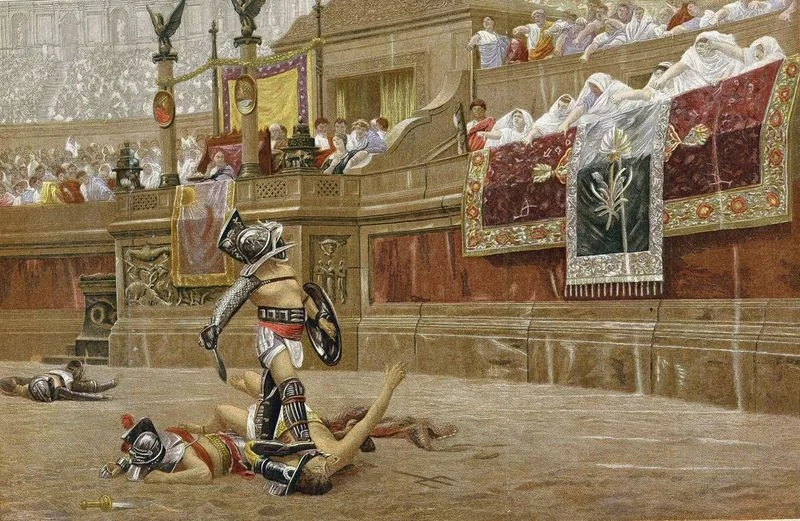Gladiators were fighters in ancient Rome.
They fought each other and wild animals.
The Colosseum in Rome was the most famous place to see them.
Most gladiators were men, but there were some women fought too.
In modern times we have fighting contests of boxing and wrestling as entertainment. In the days of ancient Rome they had gladiators.
The remains of the Colosseum today. ©Getty Images
In ancient times, when the Roman Empire ruled over a great deal of Europe, public entertainment was provided in huge venues, called amphitheatres (say am-fee-theatres), the most famous of which was the Colosseum (say coll-uh-see-um) in Rome.
Today, actors dressed as gladiators greet tourists at Rome's colosseum image © [2007] Jupiterimages Corporation
The entertainment took the form of combat, and people called gladiators fought each other, or wild animals such as lions, to the death. Generally, gladiators were condemned criminals, prisoners of war, or slaves. Criminals who had been found guilty of murder and condemned to death went into combat without weapons. Criminals who had committed other crimes were trained in special gladiator schools, called ludi (say loo-dee), and they fought with weapons of their choice. They could earn their freedom if they survived 3-5 years of combats. However, although gladiators generally fought about 3 times a year, few survived 3-5 years.
The Ludus Magnus was the principal gladiator school, smaller ones were ludi, a word which was also used as a name for gladiatorial games. Gladiators in the ludi were trained like professional athletes. They were fed three meals a day and given medical attention if needed. Training included using different weapons such as war chain, net, trident, dagger and lasso. They were taught combat techniques that disabled and captured their opponents rather than killed them. They wore armour in combat, but not the same armour as the Roman army.
Professional gladiators were free men who volunteered to participate in the games. These gladiators were paid each time they fought.
Museum display of armour worn by Roman soldiers
Gladiators wore the armour of Rome's enemies, so that the Roman people wouldn't see what looked like a Roman soldier losing a match.
Some of the enemy uniforms that gladiators wore were:
Samnite, which included a large oblong shield (called scutum), a metal or boiled leather grieve (ocrea) on the left leg, a visored helmet (galea) with a large crest and plume, and a sword (gladius).
Thracian, including ocrea on both legs, a small square shield, either a full visored helmet or an open faced helmet with a wide brim, and a curved sword.
Secutor, naked except for an ocrea on the left leg, leather bands at the elbow and wrists (manicae), a helmet, and carrying only a large oval or rectangular shield and a sword or dagger.
Retiarius, (fisherman) wearing only a loin cloth (subligaculum) and a metal shoulder-piece (galerus) on the left arm, and carrying a net (iaculum), a dagger, and a trident (fascina..a three-pronged spear).
Laquearii, similar to the Retiarius but with a lasso instead of a net.
The winning gladiator asked the crowd whether or not the defeated gladiator was to be allowed to live or was to be killed. © Jupiterimages Corporation
Popular with spectators
Large crowds packed the amphitheatres to watch the gladiators. When one of the gladiators in a contest was wounded, the crowd went wild. If one of the gladiators felt he was defeated, he would raise his left hand with one finger extended. This was to ask for mercy. It is believed that the crowd voted for death or to spare him by signalling with their thumbs: thumbs up and the gladiator lived, thumbs down and his opponent was to kill him. The defeated gladiator knelt at the feet of the winner and was killed. The winner would receive a prize, such as a golden bowl, crown, or gold coin, along with a palm leaf that symbolised victory.
Successful gladiators, or those who fought in a spectacular way, were regarded as heroes, rather like exceptional athletes are today.
Also like today’s spectator sports, gladiator games became a huge business for sponsors, trainers and promoters. Wealthy and influential politicians often owned gladiator schools and would put on gladiator games to win votes. However it became a very expensive business that began to decline in popularity during the 4th century as people became bored. Gladiator games were banned when Christianity became the state religion at the beginning of the 5th century, replaced by hugely popular chariot races and theatrical shows such as the re-enactment of famous battles, including sea battles with real ships sailing the flooded arena.
Women as gladiators
Women gladiators, known as gladiatrix, once competed in the arena. Emperor Septimius Severus, who ruled from 193 to 211 AD, allowed women to fight but later banned the practice in 200 AD.
Combat vs wild animals
When the crowds began to lose interest in the spectacle of gladiators fighting each other, wild animals were introduced as a new aspect of violent combat. The men who fought wild animals were not gladiators, they were called bestiari. Most were criminals and the combat was a way of executing them cheaply.
Many thousands of Barbary lions was were slaughtered in gladiatorial combat. They are now extinct, not entirely by gladiator combat. ©Getty
Lions, rhinos, crocodiles, hippos, cheetahs, tigers, leopards and bears were brought to Rome from all the lands that were ruled by Rome. Many species were brought to the brink of extinction as many thousands of animals were slaughtered in these combats.
It’s a good idea to get information from more than one source!
Read more about gladiators of ancient Rome:
https://www.historyforkids.net/roman-gladiators.html
https://www.dkfindout.com/us/history/ancient-rome/gladiators/
Watch a video about the Colosseum
https://www.youtube.com/watch?v=e-x74MFiWkg



![Today, actors dressed as gladiators greet tourists at Rome's colosseum image © [2007] Jupiterimages Corporation](https://images.squarespace-cdn.com/content/v1/56a1a14b05caa7ee9f26f47d/1464570133086-SZ31FMC7EMFJ2CFMHB4B/gladiatorjup2.jpg)


